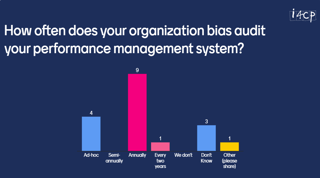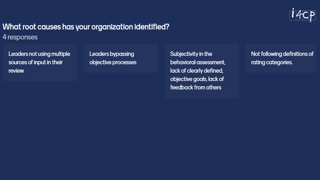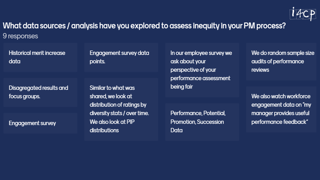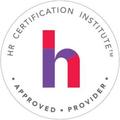Perception of bias in performance management is itself a drag on performance, well-being, and employees’ feelings of belonging. But high-performance organizations are 4X more likely to conduct bias auditing on their performance management process, which is key to ensuring that all employees have the same opportunities at compensation, career advancement, and other forms of recognition.
In this joint meeting, the Diversity, Equity, & Inclusion Exchange and the Performance Management Exchange explored how these two functions collaborate to achieve shared goals of creating equitable performance management processes, including bias auditing, giving effective and fair feedback, leader accountability, and career mobility and access.
|
|
|
Debating Executive Presence: Subjectivity in Performance Management
|
|
|
|
To open the discussion, members discussed the example of assessing "executive presence" within their talent systems. We delved into its nuances, particularly in terms of addressing bias and subjectivity.
|
|
|
|
😇 Addressing the Halo Effect
Charisma can often be mistaken for competence, creating biases in performance evaluations. Organizations should distinguish between true leadership capabilities and superficial traits.
|
|
|
|
👥 Mitigating Proximity Bias
In hybrid and remote work settings, those with more face-to-face interactions with executives can be unfairly advantaged. Ensuring fair evaluation methods that do not overly favor proximity is crucial.
|
|
|
|
🕴️ Embracing Diverse Leadership Styles
Recognize and value different leadership and communication styles. Explicitly state unspoken rules and expectations to foster an inclusive environment.
|
|
|
|
👔 Defining Executive Presence Clearly
Clearly define what executive presence means within the organization, ensuring it includes a variety of leadership styles and does not rely on subjective impressions.
|
|
|
Mitigating Bias & Fostering Equity: Inclusive Performance Management
|
|
During a panel discussion, hosted by our i4cp Champion, Pat Murakami, we explored the relationship between DE&I and performance management. The conversation highlighted the importance of clear communication, the use of data to guide decisions, and the necessity of a partnership approach to foster an inclusive and equitable work environment.
|
|
|
|

|
|
Chantelle Johnson
Associate VP, Enterprise Diversity, Equity & Inclusion – Workforce & Culture
Humana
|
|
|
|

|
|
Amelia Ransom
VP, Diversity, Equity and Inclusion
Smartsheet
|
|
|
|

|
|
Roz Tsai
Vice President, Talent, Learning & Organizational Effectiveness
Thrivent
|
|
|
|
Panel Take-aways
- Committed Collaboration: Regular and continuous discussions between DE&I and performance management teams are essential for aligning objectives. Embracing the "disagree and commit" mantra encourages teams to move forward unitedly even when there are disagreements.
- Bias Audits: Conducting bias audits within performance management processes helps identify and mitigate unconscious biases, ensuring fair evaluations and opportunities for all employees. See i4cp's Bias Audit Workbook for Performance Management.
- Data-Driven Decisions: Utilizing data to guide decisions and measure outcomes is crucial. Establish clear goals and use relevant data to track progress and make informed adjustments.
- Shared Accountability: DE&I goals should be recognized as a collective responsibility across the organization, not solely the DE&I team's burden. This shared accountability enhances the effectiveness and reach of DE&I initiatives.
- Growth Mindset: Embrace change management principles to foster a culture of continuous improvement. Engage all HR facets in this mindset to drive organizational growth and inclusivity.
|
|
|
Root Causes of Inequity in Performance Management Systems
|
|
|
|
Members were divided into breakout rooms to discuss the sources of inequity in their performance management systems, including bias, lack of effective and equitable feedback, and issues with leader accountability. Each group explored challenges and strategies related to their respective topics, providing valuable insights on improving practices within organizations.
|
|
|
|
Room 1: Bias
- Bias Disruption: Implement planned interventions to disrupt biases in specific practices.
- Partnership and Data Utilization: Use data to guide partnership decisions and ensure alignment with organizational goals. Embrace the concept of "disagree and commit" with shared accountability, allowing for corrections when necessary.
- Annual and Ad-Hoc Bias Checks: Conduct annual reviews of disaggregated responses to identify areas of concern, with some organizations employing more ad-hoc approaches.
- Conscious vs. Unconscious Bias: Highlighted the need for different strategies to address conscious bias, emphasizing that not all biases are unconscious.
- Competing Priorities: Acknowledged that competing priorities within Performance Management (PM) can complicate efforts to address bias effectively.
|
|
|
|
Room 2: Effective and Equitable Feedback
- Quarterly Performance Discussions: Implement regular performance discussions on a quarterly basis to ensure continuous feedback.
- Transparency in Expectations: Maintain clear and transparent communication regarding goals and behavioral expectations with staff.
- Training on Feedback: Provide training on delivering effective feedback and holding productive conversations.
- Equitable 1:1 Time: Ensure all employees receive equal one-on-one time with managers for feedback.
- Tech Tools: Utilize technology tools, such as Textio, to facilitate effective feedback processes.
- Biannual Performance Reviews: Require performance reviews to be conducted twice a year to maintain consistent evaluation.
|
|
|
|
Room 3: Leader Accountability
- Challenges in Addressing Leader Bias: Acknowledge the difficulties in calling out leaders on their biases due to potential negative impacts on dialogue and defensiveness.
- Raising Awareness: Stress the importance of raising awareness about biases during evaluation conversations and in calibration rooms, despite the challenges.
- Structural Support: Emphasize the necessity of strong structures to mitigate biases, recognizing the difficulty of holding numerous leaders accountable, particularly in large organizations.
- Employee Feedback Surveys: Employ surveys to gather employee perspectives on performance conversations, focusing on the frequency and quality of feedback and coaching.
- Transition to Frequent Conversations: Note the shift from annual reviews to more frequent performance conversations to ensure ongoing feedback and development.
|
|
|
Go Deeper with Further Resources
|
|
View the full results of the meeting polls and add your own anonymous responses!
|
|
|
|
How often does your organization bias audit your performance management system?
|
|
|
|
What root causes has your organization identified?
|
|
|
|
What data sources / analysis have you explored to assess inequity in your PM process?
|
|
|
|
|

|
|
Click here to participate in live poll through 05/20/2024
|
|
|
|

|
|
Click here to participate in live poll through 05/20/2024
|
|
|
|

|
|
Click here to participate in live poll through 05/20/2024
|
|
|
This meeting is exclusively for members of the Diversity, Equity, and Inclusion Exchange, Performance Management Exchange.
If you'd like to participate, please contact us to see if you qualify.
If you are an i4cp member, please log in to access the registration/meeting details.
log in
This event is approved for certification credits.










